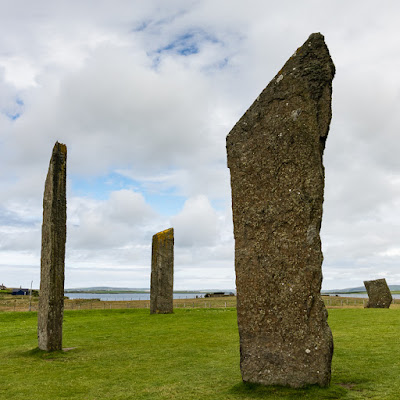Although Stenness is a smaller circle than that at Brodgar, the stones themselves are much bigger, with a maximum height of six metres. Four stones remain, from an original 10 or 12 that were laid out in an ellipse. At the centre of the ring is a large stone hearth, similar to those found in Skara Brae and other Neolithic settlements.
A quick note on photography in Orkney. First off, the weather. Weather forecasts can only be trusted for the following hour, after that they become increasing random guesses. With no hills, few trees and no major land masses to the west until you reach Newfoundland, weather fronts seem to whip through the isles. Yes, of course it’s going to rain! It’s the far north of Scotland, what did you expect? But in Orkney, more so than anywhere else I’ve been in the UK, the old joke applies that, ‘if you don’t like the weather, just wait 10 minutes’. Secondly, people. The other touristy types who like to stand in front of you just as you're trying to take a shot. Given the location, it should probably not be surprising that the many attractions Orkney has to offer aren’t constantly thronged by visitors. What there are, however, are coachloads of day-trippers, intent on seeing all that Orkney has to offer in a single hit. It can be rather disheartening to turn up somewhere at the exact time as a couple of 57-seaters. All you can do is wait them out. Fortunately their itineraries preclude them from staying at one location for too long (“and we’re walking, we’re walking”). Just watch out for the next coach.
A short walk past the stones, on the shores of Loch Harray, is the remains of the neolithic Barnhouse Settlement. Only the partially reconstructed foundations of the buildings remain. These are thought to date from between 3300 and 2600 BC. A total of 15 buildings were unearthed during an archaeological dig in the 1980's. The houses were similar in construction to those at Skara Brae, but were free standing rather than built into the earth and a midden pile. From their layouts, two of the buildings, 'Structure 2' and 'Structure 8', are thought to have been used for ceremonial purposes, rather than as dwellings. It is also thought that 'Structure 8', which is aligned with the Barnhouse Stone and Maeshowe, was built after the rest of the village had been abandoned and purposefully destroyed.







No comments:
Post a Comment